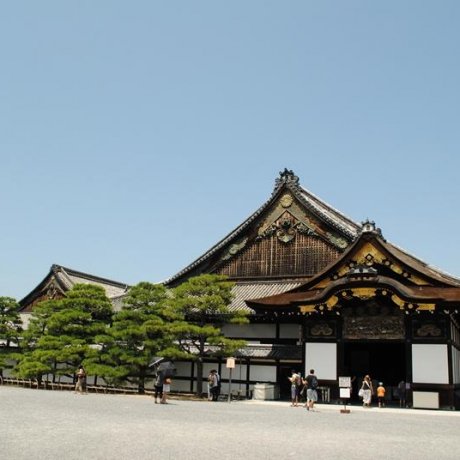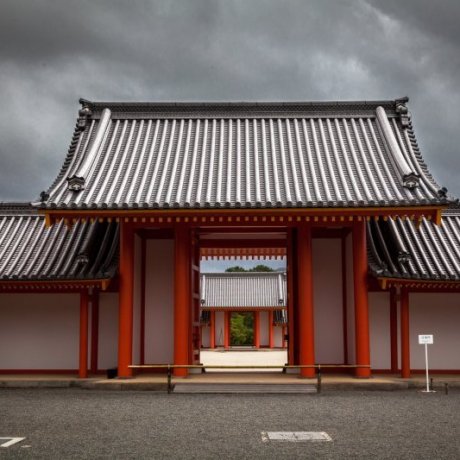
Nijo Castle: Former Imperial Residence
Katrina WebberBuilt under the order of Tokugawa Ieyasu, Nijo-jo has served as the home of the Tokugawa shogun, an Imperial property, and is now..

Nijo Castle is one of the most accessible UNESCO spots in Kyoto, being just a short walk from Nijojo-mae Station. The former residence of the Tokugawa shoguns, the sprawling castle grounds are surrounded by a wide moat and massive stone walls. Spanning over 275,000 square metres, Nijo Castle is one of the biggest historic sites in all of Kyoto.
Structural reinforcement and restoration will be carried out on all historic structures within Nijo-jo Castle. The various renovations are planned as follows: Honmaru-goten Palace (2017-2023), Tamarigura (2024-2027), Ninomaru-goten Palace (2024-2036), and Tonan Sumi-yagura (2028-2036). Read more
Established in 1626, Nijo Castle was built by a combined effort from all the feudal lords in Western Japan at the time. Since then, multiple buildings have been damaged by fires or storms, and extra effort is taken by the city to preserve and restore this cultural site. Nijo Castle is designated as a Historic Monument of Ancient Kyoto, making it one of the prefecture's most significant sites.
Within the castle grounds is Ninomaru Palace, a 3,300-square meter complex made almost completely out of Hinoki cypress wood. The palace interior is adorned with gold leaf-plated decor and exquisite wood carvings, making it a fitting place to entertain powerful political visitors during the shogunate's ruling period.
The 3,300-square-meter palace grounds are a must-see when at Nijo Castle. The palace buildings are made entirely out of Japanese Hinoki cypress wood and contain a wealth of original historical artefacts within the building. Elaborate paintings adorned with gold leaf decorate the sliding doors of the palace rooms, intentionally done to impress important visitors.
A short walk from City Bus Stop Nijo-jo-mae (from JR Kyoto Station/Hankyu Railway Karasuma Station), or Nijo-jo-mae Station on the Tozai Subway Line

Built under the order of Tokugawa Ieyasu, Nijo-jo has served as the home of the Tokugawa shogun, an Imperial property, and is now..
 7
7
A short photographic introduction to Nijō Castle's cherry blossom illumination

A visit to the Shogun's Palace. An extract from “Revolutions: Wandering and wondering on a sabbatical year”.
 12
12
Nijo-jo Castle was the official lodging for the Tokugawa Shogun when staying in Kyoto. Tokugawa Ieyasu (the 1st Shogun) started..
 10
10
Nijo-jo Castle, Kyoto, is colorful year round, but it is also beautiful in B&W.
 12
12
Nijo-jo Castle, Kyoto, has many magnificent details that will surprise you.
 12
12
Nijo-jo Castle in autumn is not vibrant with reds and oranges and purples like many other well-known Kyoto temples and gardens...
 9
9
I recommend the Waraku-an teahouse in Seiryu-en Garden. It's only 700 yen for a cup of tasty green tea, delicate Japanese sweets,..
 12
12
Nijo-jo Castle in Kyoto is beautiful during the spring cherry blossom season. Since the grounds are large, be sure to commit an..

Aizenkobo is a story of renewal – A primer to what it means to be the lifeblood of Kyoto art and culture
 12
12
Waraku-an is a comfortable teahouse in Seiryu-en Garden at the World Heritage Site, Nijo Castle. The well-trimmed beautiful garden..

Sakura season is one of Japan's most exciting times of the year, and digital art collective Naked Inc. is bringing the ethereal..

Digital art events have exploded in number over recent years, and one art collective at the forefront of this in Japan is NAKED...

A seasonal event by digital art collective NAKED at the World Heritage listed Nijo Castle combines projection mapping with the historic..

This summer, Kyoto's Nijo Castle will be transformed into a multisensory nighttime art experience with “NAKED meets Nijo C..

HOTEL CANATA KYOTO offers 16 contemporary styled rooms within a stone's throw of the UNESCO World Heritage Site of Nijo Ca..

More like a chic home stay from an interior decoration magazine, this guesthouse is both elegant and comfortable.

Close to Nijo Castle in Japan's most historic city, this stylish, modern hotel is comfortable, well located and supremely affordable...

Cooking Garden Charanke Restaurant is the place for Okinawan culture and cuisine in Kyoto

Did you know that Lipton tea brand had its own Tea House in Kyoto? Tea House Lipton opened in 1930 to promote Lipton tea along..

Inoda chronicles the tale of Spring Water at its stores in Nijo and Kiyomizu districts of Kyoto.

Located in the heart of the city, Kyoto Gyoen National Garden is a natural oasis perfect for escaping the busyness of urban life. This vast green space..

The Kyoto Imperial Palace is the former ruling palace of the Emperor of Japan. Since the Meiji Restoration in 1869, the Emperors have resided at the Tokyo..

Known for its academic blessings, Kitano Tenmangu is a Shinto shrine in Kyoto’s Kamigyo ward that is dedicated to Sugawara no Michizane, an influential..
Your feedback has been sent.